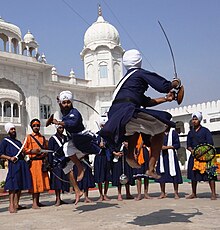| Khalsa | |
|---|---|
| ਖ਼ਾਲਸਾ | |
 | |
| Active | 13 April 1699 – present |
| Allegiance | Waheguru |
| Branch | |
| Type | Sikh religious order |
| Headquarters | Panj Takht, Akal Takht Sahib,[1] Anandpur Sahib[2] |
| Motto(s) | Deg Tegh Fateh |
| Colors | Navy blue and xanthic[3][4] |
| Anniversaries | Vaisakhi, Holla Mohalla, Bandi Chhor Divas |
| Commanders | |
| Founders | Guru Gobind Singh Mata Sahib Kaur |
| Panj Pyare | |
| Jathedar of the Akal Takht | disputed
|
| Insignia | |
| Insignia | Khanda |
| Individual/Personal Identification | The Five Ks |
| Corporate/Panthic Identification | Nishan Sahib |
| Predecessor (military) | |

| Part of a series on |
| Sikhism |
|---|
 |


The term Khalsa[a] refers to both a community that follows Sikhism as its religion,[5] as well as a special group of initiated Sikhs.[6] The Khalsa tradition was initiated in 1699 by the Tenth Guru of Sikhism, Guru Gobind Singh. Its formation was a key event in the history of Sikhism.[7] The founding of Khalsa is celebrated by Sikhs during the festival of Vaisakhi.[8][9][10]
Guru Gobind Singh started the Khalsa tradition after his father, Guru Tegh Bahadur, was beheaded during the rule of the Mughal Emperor Aurangzeb after the Hindu Brahmins requested for his help to save their religion.[11][12][13] Guru Gobind Singh created and initiated the Khalsa as a warrior with a duty to protect the innocent from religious persecution.[14] The founding of the Khalsa started a new phase in the Sikh tradition. It formulated an initiation ceremony (amrit sanskar, nectar ceremony) and rules of conduct for the Khalsa warriors. It created a new institution for the temporal leadership of the Sikhs, replacing the earlier Masand system. Additionally, the Khalsa provided a political and religious vision for the Sikh community.[5][15][16]: 127
Upon initiation, a male Sikh was given the title of Singh meaning "lion". Kaur was made the sole, compulsory identifier for female Sikhs in the twentieth century. The rules of life include a behavioural code called Rahit. Some rules are no tobacco, no intoxicants, no adultery, no Kutha meat, no modification of hair on the body, and a dress code (Five Ks).[16]: 121–126
- ^ the seat of supreme temporal authority for Sikhs
- ^ "Sikh Reht Maryada, The Definition of Sikh, Sikh Conduct & Conventions, Sikh Religion Living, India". Old.sgpc.net. Retrieved 4 June 2022.
- ^ Sikh Rehat Maryada: Section Three, Chapter IV, Article V, r.
- ^ Nishan Sahib (Sikh Museum)
- ^ a b Khalsa: Sikhism, Encyclopaedia Britannica
- ^ Singh, Pashaura; Fenech, Louis E. (2014). The Oxford Handbook of Sikh Studies. Oxford University Press. p. 237. ISBN 978-0-19-969930-8.
- ^ Singh, Nikky-Guninder Kaur (2012). The Birth of the Khalsa : A Feminist Re-Memory of Sikh Identity. State University of New York Press. p. xi. ISBN 978-0-7914-8266-7.
- ^ Senker, Cath (2007). My Sikh Year. The Rosen Publishing Group. p. 10. ISBN 978-1-4042-3733-9., Quote: "Vaisakhi is the most important mela. It marks the Sikh New Year. At Vaisakhi, Sikhs remember how their community, the Khalsa, first began."
- ^ Cole, p. 63: "The Sikh new year, Vaisakhi, occurs at Sangrand in April, usually on the thirteenth day."
- ^ Jacobsen, Knut A. (2008). South Asian Religions on Display: Religious Processions in South Asia and in the Diaspora. Routledge. p. 192. ISBN 978-1-134-07459-4., Quote: "(...) for the Sikhs, it [Baisakhi] celebrates the foundation of the Khalsa in 1699."
- ^ Cite error: The named reference
Mandair2013p53was invoked but never defined (see the help page). - ^ Cite error: The named reference
cs2013was invoked but never defined (see the help page). - ^ Cite error: The named reference
fenech4was invoked but never defined (see the help page). - ^ Cite error: The named reference
colesambhi36was invoked but never defined (see the help page). - ^ Singh, Teja (2006). A Short History of the Sikhs: Volume One. Patiala: Punjabi University. p. 107. ISBN 978-8173800078.
- ^ a b Singh, Kartar (2008). Life of Guru Gobind Singh. Ludhiana, India: Lahore Bookshop.
Cite error: There are <ref group=lower-alpha> tags or {{efn}} templates on this page, but the references will not show without a {{reflist|group=lower-alpha}} template or {{notelist}} template (see the help page).